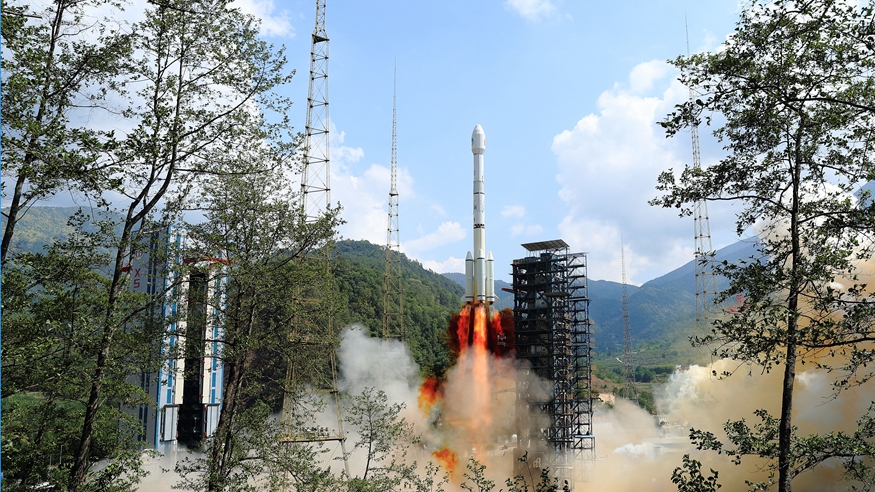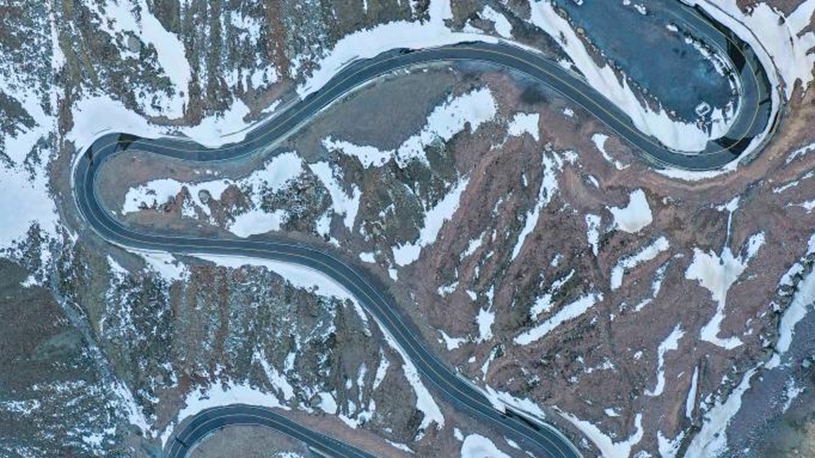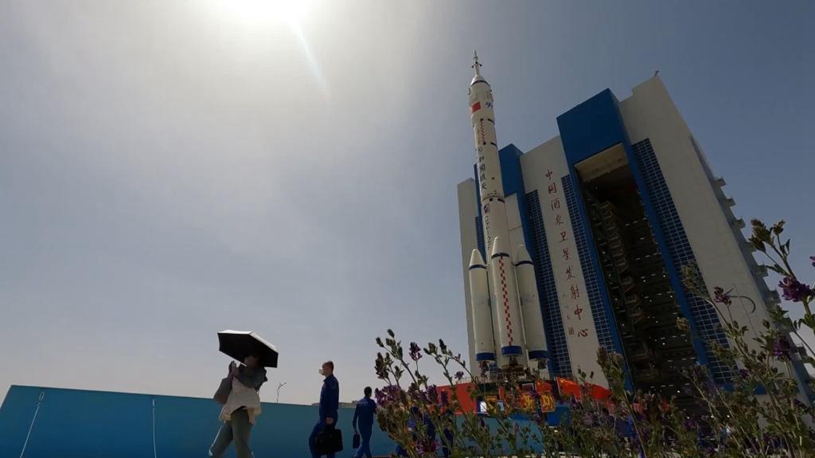* A Chinese expedition team on Tuesday reached the summit of Mount Qomolangma.
* The feat came almost 70 years after man's first successful expedition to the top of the world.
* The 2023 Mt. Qomolangma expedition is part of the second comprehensive scientific expedition on the Qinghai-Tibet Plateau, initiated in 2017.
MOUNT QOMOLANGMA BASE CAMP, Tibet, May 23 (Xinhua) -- A Chinese expedition team on Tuesday reached the summit of Mount Qomolangma, the world's highest peak, where they carried out scientific research.
The feat came almost 70 years after man's first successful expedition to the top of the world, when New Zealander Edmund Hillary and Tenzing Norgay from Nepal summited Mt. Qomolangma from the south ridge on May 29, 1953.

Members of a Chinese expedition team display the Chinese national flag at the summit of Mount Qomolangma on May 23, 2023. (Photo by Lhagba/Xinhua)
An important mission of this year's expedition is to maintain and upgrade the eight weather stations at altitudes between 5,200 meters and 8,830 meters to ensure the establishment of the gradient meteorological observation system in the Mt. Qomolangma region and realize long-term continuous observation work.
The 13 members of the expedition departed the Assault Camp at an altitude of 8,300 meters at 3 a.m. Tuesday and arrived at the weather station at an altitude of 8,830 meters -- the highest weather station in the world -- after several hours of arduous climbing.
After affixing steel ropes, replacing batteries and installing wind speed and direction sensors, they completed upgrades to the components of the weather station.

Members of a Chinese expedition team maintain and upgrade equipment at the 8,830-meter weather station on Mount Qomolangma, May 23, 2023. (Photo by Lhagba/Xinhua)
They then climbed to the 8,848.86-meter-high summit at around 12:30 p.m. and successfully collected ice and snow samples, which will be used for the observation and research of air pollutants, particularly new pollutants.
The Qinghai-Tibet Plateau, where Mt. Qomolangma is located, is known as the "roof of the world" and the "water tower of Asia." It is an important ecological security barrier in China.
As the most unique geological, geographical, resource and ecological region on Earth, the Qinghai-Tibet Plateau has been called the "natural laboratory" by the scientific community, and Mt. Qomolangma is one of the world's areas of greatest concern.
The 2023 Mt. Qomolangma expedition is part of the second comprehensive scientific expedition on the Qinghai-Tibet Plateau, initiated in 2017.
Since the end of April, a total of 170 scientists across five teams have been conducting research on the water, ecology and human activities around the Mt. Qomolangma region, aiming to reveal the mechanism of environmental change and optimize the ecological security barrier system on the plateau.
EXPLORING THE UNKNOWN
About 65 million years ago, the Tibetan Plateau rose from the collision of plates. To this day, the plateau continues to change dramatically and profoundly affect human life.
Kang Shichang, a researcher at the Northwest Institute of Eco-Environment and Resources under the Chinese Academy of Sciences (CAS), has led a team to physically examine the glaciers.
This year, they used drones, 3D laser scanning and other advanced equipment to monitor pollutants and changes in glaciers and glacial lakes, and to monitor greenhouse gas fluxes in rivers and lakes from the base camp all the way to the East Rongbuk Glacier.

This aerial photo taken on May 23, 2023 shows the mountaineering base camp in the Qomolangma National Nature Reserve in southwest China's Tibet Autonomous Region. (Xinhua/Sun Fei)
"We have just drilled an ice core from 6,500 meters, and the longest ice core drilled this year was 118.7 meters," said Kang, noting that the ice cores will provide a wealth of information on the history of climate change in the region.
Su Tao, a researcher at the Xishuangbanna Tropical Botanical Garden under CAS, has led a team of four to carry out a field investigation in the Mt. Qomolangma region over the past two weeks, trying to decipher the "unique code" of paleontology.
"Paleontological fossils have a unique advantage because the shape and distribution of organisms are closely related to the environment, as different natural environments have shaped different organisms," said Su, 41.
The atmospheric science team led by Wang Yilong from the Institute of Tibetan Plateau Research under CAS carried out the continuous observation of greenhouse gases on the Qinghai-Tibet Plateau using high-precision instruments and unmanned aerial vehicles.
They integrated the observation data into an atmospheric response model to accurately estimate the current situation of carbon sources and sinks on the plateau, and to help formulate the strategic goal of achieving a carbon peak and neutrality in China.
"This year's expedition has greater disciplinary coverage and more extensive representation of scientists, and features more advanced equipment. In particular, the new batteries, which have been developed in collaboration with the lunar exploration project, will provide reliable energy supplies for the operation of instruments and equipment in the extreme environment near the summit," said An Baosheng, the on-site commander of the expedition.

Members of a Chinese expedition team head for the summit of Mount Qomolangma on May 23, 2023. (Photo by Lhagba/Xinhua)
"We have made many achievements of international influence, which could not have been realized without a number of scientific breakthroughs and records set by the expedition team members on Mt. Qomolangma," said Yao Tandong, a CAS academician and the team leader of the second comprehensive scientific expedition on the Qinghai-Tibet Plateau.
"The 2023 Mt. Qomolangma expedition has expanded the breadth and depth of the second comprehensive scientific expedition on the Qinghai-Tibet Plateau. I believe that more and more 'unsolved codes' will be deciphered," said Li Meng, vice minister of science and technology.
SCALING THE UNTRODDEN
On May 25, 1960, a Chinese mountaineering team reached the summit of Mt. Qomolangma from the north ridge, once considered insurmountable, for the first time in human history. From 1958 to 1960, in order to facilitate the summit attempt, CAS organized a 46-member expedition to investigate the geography, geology, geomorphology, meteorology and hydrology of the Mt. Qomolangma region.
"In the 1950s and 1960s, what we did was called mountaineering scientific expedition. Mountaineering was the first goal, while scientific expedition ranked second," Yao said.

This aerial photo taken on May 23, 2023 shows a view of Mount Qomolangma. (Xinhua/Sun Fei)
Scientists, as independent forces, later made various investigations in the area, which were carried out in parallel with mountaineering. But most could only conduct research at a height of up to 6,000 meters. There were few scientific research samples collected at a height of over 8,000 meters, and there were still many research gaps.
Over the past 60 years, countless Chinese climbers and researchers have come to Mt. Qomolangma to measure its height with their footsteps and to inquire with a scientific attitude.

Scientific research members applause as they receive data from the 8,830-meter weather station at the mountaineering base camp in the Qomolangma National Nature Reserve in southwest China's Tibet Autonomous Region, May 23, 2023. (Photo by Tenzin Norbu/Xinhua)
"Inside, I'm still very excited to be here," said Kang, who has made 12 scientific expeditions on Mt. Qomolangma over the past 26 years. Every time he travels to the mountain, he hikes to the Advance Camp and the glacier lake at an altitude of 6,500 meters.
"Our study of the changes and the pollutants in the glaciers allows us to see the global and regional impacts of human activities on the Mt. Qomolangma region," Kang said.
"Every ascent is a tribute to it," said Penpa Dondrup, who is a member of the ongoing expedition and had previously ascended to the top of the mountain six times. This year, he successfully made his 7th summit.
"It is a great honor for me to integrate my mountaineering career into the national scientific research cause and contribute my modest efforts," he said.
"In field scientific research, we often need to sleep in tents. Working at a high altitude often brings mountain sicknesses. It is really hard," said Liu Jia, a paleontologist. "But when I unearth a complete stratum, I am extremely excited, which is also the greatest fun of scientific research!"
Scientific research on Mt. Qomolangma has been consistently carried out with updated equipment and technology. From rough descriptions of the mountain to the revelation of its various mechanisms, the Chinese people's unremitting spirit of seeking knowledge about nature has been highlighted, Yao added.
(Video reporters: Lodro Gyatso, Sonam Dekyi, Zhu Cong, Chen Zepeng, Lhapa; video editors: Hong Yan, Hui Peipei, Zheng Xin, Ma Ruxuan) ■












